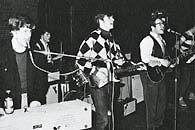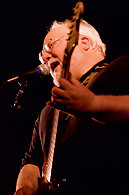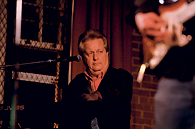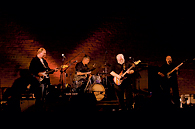Roots ’66
Four decades later, the Hanseatic League keeps on rocking us Batesies
The Hanseatic League never made it to “first hit record,” but in ways that counted, Bates’ first rock band was the real deal.

The Hanseatic League at Chase Hall, 1966-67
Founded in 1966, the original League — Rich Hager ’69, Larry Power ’69, Gary Earle ’70, Malcolm “Mac” Reid ’67, and Mark Horton ’68 — electrified the Saturday night Chase Hall dances. A later lineup gigged from Cape Cod to Québec. They opened for Jimi Hendrix in Lewiston. Hey, they were spat upon by Janis Joplin at a Wesleyan frat party!
So when the College invited the quintet to perform at Reunion in 1988, 20 years after the League’s demise, it was a mixed blessing. “It was the most nervous I’ve been other than opening for Hendrix,” says lead guitarist Power. “Frankly, I didn’t know whether we were going to pull it off or not.” Without the incentive of money or fame outside a fiercely loyal Bates following, the League’s reunion was a leap of faith borne on the wings of friendship within the band.
When the League came along, the Bates campus still lingered in the 1950s in many respects. Bates was welcoming a new president, Hedley Reynolds, prompting the Mirror to note hopefully that “there is an air of eagerness, alertness, and improving change at Bates.” But classes still ran through Saturday morning, the work was hard, and the parietals, which put the burden of proper behavior on the women, kept the genders socially separate.
The League, however, “really shook the place up,” says Mike Traverso ’67, who covered the quintet in a November 1966 Bates Student. The electric jolt they gave the campus social scene announced a new restlessness among the students, and suddenly Betty Bates was dancing on the tables. With the Hanseatic League, the ’60s arrived at Bates.
Like the Beatles in Hamburg or the Byrds at Ciro’s, the Hanseatic League forged its sound and reputation playing Chase Hall dances during 1966-67. Indeed, not since the Bates Bobcats of the 1930s and 1940s had Chase featured a live house band. “Chase was the only place to find people of the opposite sex,” explains Jill Howroyd Lawler ’68. “Naturally, having a live band was much better than a deejay.”
“The very first night we rehearsed, the Chase Hall Dance Committee came to hear us,” says Hager, who played rhythm guitar. “They said we were booked for Saturday.”
As Traverso noted mildly in the Student of Nov. 16, 1966, “the typical ‘somber Batesey’ Saturday night has been converted into a showcase of great popular sounds by these talented young musicians.”

Larry Power: lead guitar and “switchboard”
The League were no cuddly moptops. They favored the shock troops of the British Invasion: the Stones, the Animals, the Kinks, Cream. They liked to play rough. “It’s almost like a punk-rock kind of thing,” Hager says. “There’s a real edge to it, and that was probably the strength of the band.”
Guitarists Hager and Larry Power, roommates throughout their four years at Bates, had started playing together as soon as they met. Power was a rocker where Hager favored folk. “He always says that he turned me on to Dylan,” Power says, “but I turned him on to ketchup.”
Keyboardist and singer Gary Earle, a friend and bandmate of Power’s from Swampscott, Mass., followed the guitarist to Bates in the fall of ’66. Drummer Mac Reid and bassist Mark Horton made the League complete except for the name, which a desperate Reid borrowed from a medieval association of German merchants. “We spent nearly as much time discussing a name as we did practicing,” says Reid, who still owns not only his original Ringo-style Ludwig drums but the original oaktag “Hanseatic League” sign for the front of them.
Power and Earle led the band. Earle reckons that he was the strongest showman and Power the best musician, although, as Reid says, “Larry and Gary could carry any group of people.” The pair picked, arranged, and sang most of the material, and did most of the yelling when the creative tension boiled over.
Earle, finicky in pursuit of his artistic vision, takes credit for much of the friction. “Even when we get together 35 years later, those same dynamics fall into place,” he says. “It’s a tribute to Larry’s and my relationship,” he adds, “because if there was disagreement in the band, we would work it out and not let it affect our friendship.”

Gary Earle, Reunion 2003
The gruff-voiced Hager, in addition to playing rhythm guitar, sang folk-inflected material like Tom Rush’s version of “Urge for Going” and a few Dylan tunes. Horton handled high harmonies, played a penetrating bass guitar and had a knack for bringing in songs that shouldn’t have worked but somehow did.
Then there was Reid. “I was probably the least-accomplished, and still am, of the group,” the drummer says, but what he lacked in finesse he possessed in a piledriver wallop. Reid also served as mediator, facilitator and, as the only member old enough to rent a vehicle, transport manager.
The League played a broad circuit in 1966 and ’67, hitting frat houses around much of Maine and heading west for community dances in Reid’s hometown of Littleton, N.H. (“It was the first thing my grandfather had heard in many years without his hearing aid,” the drummer notes.)
Reid recalls one prep-school gig. “These high school girls were screaming and yelling,” he says. “We felt like the Beatles that night.”
Not all road trips were as enjoyable. One night, coming home from the north, the band’s borrowed British-made Commer van went feverish and finally collapsed at an all-night gas station. “I think there is a picture someplace of guys sleeping all over the place in the bathroom, on the john, on the sink, on the floor of this garage,” Reid says.
Reid graduated in ’67 and left the band. “I was very sad,” he says. “I just never have had that kind of experience in the rest of my life.” The post-Reid League, with Earle’s classmate Ted Callaghan on drums, would perform less often, but two gigs in March 1968 attained legend status: opening for the Jimi Hendrix Experience in Lewiston and playing the Wesleyan University frat party where Horton was anointed by Janis Joplin.
At Wesleyan, the League was booked for a major frat bash while Joplin’s band, Big Brother & The Holding Company, played an all-campus event. The League went on around 1 a.m., and Joplin came over to hear them.
“Around three o’clock in the morning we took a break,” Hager recalls, “and Mark and I were standing there, and Joplin asked Mark, ‘Well, as a fellow musician, what did you think?’ And he said, ‘Really honestly?’ and she said ‘Yeah.’
“And he said, “I thought you were incredible, but the band isn’t up to what you can deliver.’ And she just spat on him.”
A week later was the Hendrix date at a packed Lewiston Armory, an event that has immortalized the League in a variety of published Hendrix histories. It was Horton, with support from dormmates, who booked the superstar-to-be for what the bassist recalls as $1,500.
The League and another local band, Terry & the Telstars, opened for Hendrix. “We were all kind of nervous,” says Horton. “I wouldn’t say it was one of our finest performances.” Earle flubbed the intro to their first song, Booker T. and the MG’s “Hip-Hug Her,” but the group had redeemed itself by the closer Cream’s arrangement of Skip James’ “I’m So Glad.”
Although Hendrix himself was distracted by equipment problems during his performance, “I was riveted,” says Earle. Even the afternoon sound check proved revelatory: Lacking bassist Noel Redding, Hendrix and drummer Mitch Mitchell played anyway. “They were, and remain to this day, the best two-piece band I ever heard in my life,” Earle says.
The League was finished by Commencement 1968. While Hendrix and Joplin added their own special kinds of, um, magic to the League experience, its essence was simple friendship, formed in a time and place that could only happen once.
“I would say fairly that we would never have connected at Bates without that band,” says Reid, a career public school educator. “I had other, better friends at Bates that I have totally lost touch with. But these guys, I still feel like they are great friends, even though we have very different lives.”
While three members settled into that lesser realm of life outside rock and roll, Power and Earle formed a band after Bates and never left music. (Today Power is lead singer and guitarist of a band he co-founded, the 12:01 Blues Band, in his hometown Swampscott. Earle, down in Fort Myers, Fla., does a solo at country clubs and nightclubs.)
When one of the social committees in 1988 asked the League to re-up for a Reunion performance, it looked like a musical stretch. Power and Earle were better musicians than ever, but the original five hadn’t played together in 21 years. Horton hadn’t performed much, and Reid and Hager had scarcely touched their instruments.
But Power, who maintains tenacious contact with people he cares about, helped pull the personalities together. “He’s like the switchboard through which everybody keeps in touch with everybody else,” says Earle.
Pulling the music together was something else. “I’ll never forget the first rehearsal,” Power recounts. “It was one of the hardest experiences in my musical life breaking the rust off after 21 years of not having played” as a band.
Yet the Reunion itself was practically a Hollywood ending. They played in the library arcade, that dim brick space beneath Ladd Library whose resemblance to a subway station made a surprisingly apt setting for a heavy-hitting band.
“The sound reverberated against the ceiling and the walls,” recalls Gretchen Hess Gage ’68. “We were blown away by how good they were and how much fun it was to hear them again.”
Fearing they’d lose the crowd if they paused, says Reid, “we played one set for an hour and 45 minutes. We almost died.”
Finally, Power says, “I remember stopping and sitting there and literally looking up in the sky and going, ‘We did it! My god, we pulled it off!'”
“It took me three or four days to calm down,” Hager laughs. “It launched me back into music,” he adds, inspiring both a guitar-collecting habit and the formation of a band with other faculty at the Richard Stockton College of New Jersey, where he teaches marine science.

The Hanseatic League, 2003: Rick Hager, Mac Reid, Larry Potter
Since that triumphant return, the League has played Bates six more times, most recently in June 2003. In some ways, for working musicians Earle and Power, a Bates date is just another gig. But what makes these performances different is the gift those two can give the others: the chance to get on a stage. Especially Reid, who rarely has an opportunity to play.
“When we do it, we’re back in college,” Power says. “It literally puts your head back to when you were that age and how much fun you were having. And really, to see the smiles on Mark’s face, or on Mac’s face particularly, and on Rich’s face while we are playing that is why I do it.”